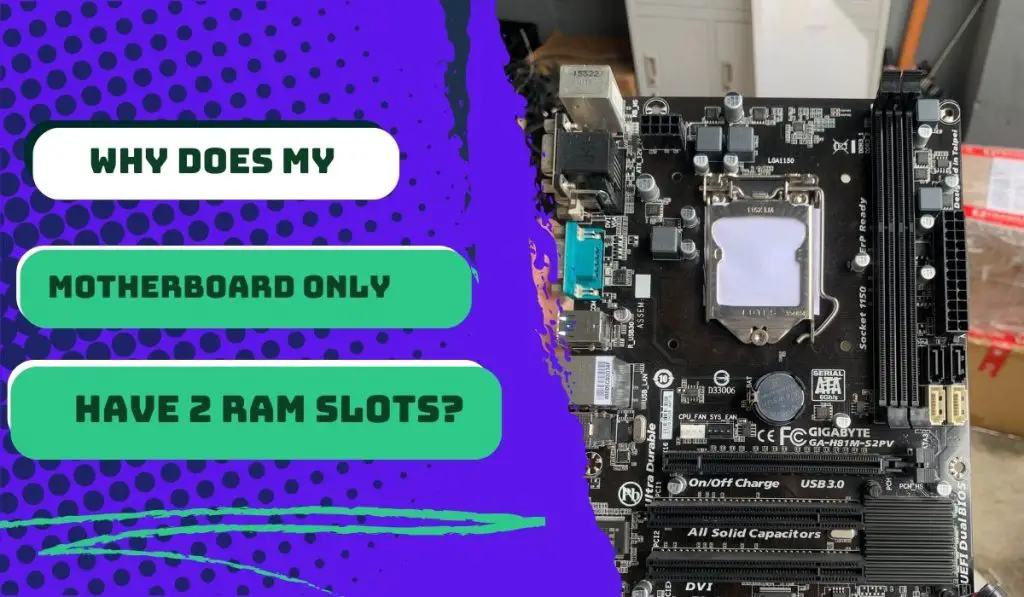A motherboard’s physical size and the number of memory controllers on the chipset determine its number of RAM slots. Motherboards with fewer RAM slots are typically smaller and designed for more budget-oriented systems. However, having only two RAM slots does not necessarily mean your system will perform poorly if you have sufficient memory capacity.
Motherboards with only 2 RAM slots tend to be cheaper and less powerful. They were created with a small form factor in mind. For example, a mini ATX has no space for four slots.
Still, some factors come into play when you have a motherboard with only 2 RAM slots because it will influence your overall experience with the board at the end of the day. But why does having only two RAM slots sound like a worry?
Does the Number of Ram Slots and Ram Placement Matter?
Yes, the number of RAM slots on your motherboard plays a crucial role since the placement of RAM can affect computer performance.
If you have only one stick, it does not matter where you put it. However, their placement and order become crucial if you have multiple RAM sticks.
A multi-channel memory architecture allows two or more RAM sticks to work together to increase the CPU’s data access speed, improving computer performance.
The number of channels used for data transfer depends on the number of RAM sticks and channels supported by the motherboard.
Dual-channel, triple-channel, and quad-channel are the most common multi-channel configurations.
While the use of a multi-channel memory architecture can improve performance, it does not guarantee a linear improvement, and the gain will vary based on memory intensity.
RAM sticks must be inserted into the designated slots on the motherboard for the multi-channel memory architecture to work.
What to Do if Your Motherboard Has only Two RAM Slots
Now that what you’ve got is a motherboard with only 2 RAM slots, here are some important things to consider before taking any steps:
- Firstly, it is essential to determine how much RAM you currently have and how much you intend to add in the future. Two slots are sufficient if you have 4GB of RAM and do not plan to add more. However, if you intend to add more than 4GB, you will need a motherboard with four RAM slots, no matter what.
- In addition, the type of RAM you use affects the number of sticks you can place in each slot. If using DDR3 RAM, two 8GB sticks can be added to each slot, totaling 16GB. In contrast, DDR4 RAM only allows one 8GB stick in each slot, limiting the maximum RAM to 16 GB.
- Also, budget considerations play a significant role in choosing a motherboard. If money is not an issue, choosing a motherboard with four RAM slots is undoubtedly the best option for you.
However, if budget constraints exist, opting for a motherboard with two RAM slots can still fulfill basic computing requirements.
Can I Do Dual-Channel with Only Two RAM Slots?
Yes, you can dual-channel with only two RAM slots, and upgrading your power supply is always an excellent idea. Then you match the existing memory or install a matched pair.
You could have a pre-built PC with 4GB of RAM but, ironically, only 2 RAM slots. Now, one of the sticks will be occupied already. So with one free slot, you may want to do dual-channel.
If you populate each slot with a RAM stick, two slots will run in dual-channel mode. So, as mentioned earlier, consider purchasing a second 4 GB stick with corresponding specifications or buying a matched 2-stick kit of supported RAM.
Now, in terms of speed, you won’t miss out on much because the difference is between 2 and 3 percent. What is more important is having sufficient RAM.
Can You Install RAM in Any Slots?
Yes, you can. But while installing RAM in any of the four slots available on your motherboard is technically possible, placing RAM in any available slot will not maximize its full potential, particularly when installing multiple modules.
In the past, older computers would fail to boot if RAM was inserted into the wrong slot. Nowadays, while it is possible to insert RAM into any slot, the computer may not boot if the RAM is incompatible.
So I recommend you check the motherboard’s user manual to determine which RAM types and speeds are compatible.
This information will help you ensure RAM modules work together correctly and achieve their maximum potential.
As you probably know, using incompatible RAM can cause the computer to crash, fail to boot, or experience performance issues.
This goes to say that taking extra caution when installing RAM is necessary, especially when using multiple modules.
If you want optimal computer performance, proper installation and compatibility are key.
Notable Motherboard with 2 Ram Slots
Having only two RAM slots does not necessarily mean that your system will perform poorly, provided you have sufficient memory capacity. Some notable (and pretty impressive) motherboards are designed with two RAM slots.
And yes, you guessed right. They are offered at incredibly affordable price points, especially on retail websites. Excellent examples of cheat motherboards with two RAM slots include the MSI H110M PRO-VD PLUS and the MSI H110M PRO-VD. The MSI A88X-G41 PC Mate also measures up in this regard.
While the aforementioned motherboards are the cheapest, they are not the most famous among PC users. Products like the ASRock B660M-HDV and Gigabyte H610M S2H DDR4 are two popular options for motherboards with two slots. The H670M-ITX/ax from ASRock is also a worthy alternative.
In a nutshell,
The reason behind motherboards with only 2 RAM slots boils down to manufacturing costs and even size, like micro-ATX and mini-ATX motherboards.
Meanwhile, some “newer” versions of these will most likely come with 4 RAM slots for 32–64GB of memory. So, if you got your motherboard relatively cheaply and it has only two RAM slots, it shouldn’t be a shocker.
If your motherboard has only two RAM slots, you will need to consider the amount of memory you need and the capacity of the RAM modules. I strongly recommend purchasing RAM modules compatible with your motherboard and have the same specifications.
To maximize the performance of your system, you can also use dual-channel memory, which uses two identical RAM modules.
My two cents on using motherboards with only two slots is to upgrade to a higher-capacity RAM module to increase the overall memory of your system.
And, buddy, before you go, remember to check your motherboard’s maximum supported memory capacity before purchasing RAM.




![How to Add More SATA Ports to Motherboard? [Guide] 5 How to Add More SATA Ports to Motherboard](https://bestofmotherboard.com/wp-content/uploads/2022/02/How-to-Add-More-SATA-Ports-to-Motherboard.jpg)
![How To Install Motherboard Drivers With USB? [Guide] 6 How To Install Motherboard Drivers With USB](https://bestofmotherboard.com/wp-content/uploads/2022/02/How-To-Install-Motherboard-Drivers-With-USB.jpg)